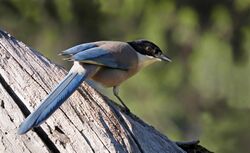Iberian magpie
Topic: Biology
 From HandWiki - Reading time: 3 min
From HandWiki - Reading time: 3 min
| Iberian magpie | |
|---|---|

| |
| In Parque natural de la Sierra de Andújar, Spain | |
| Scientific classification | |
| Domain: | Eukaryota |
| Kingdom: | Animalia |
| Phylum: | Chordata |
| Class: | Aves |
| Order: | Passeriformes |
| Family: | Corvidae |
| Genus: | Cyanopica |
| Species: | C. cooki
|
| Binomial name | |
| Cyanopica cooki Bonaparte, 1850
| |
| Synonyms[2] | |
|
Cyanopica cyana cooki | |
The Iberian magpie (Cyanopica cooki) is a bird in the crow family. It is 31–35 cm (12–14 in) long and similar in overall shape to the Eurasian magpie (Pica pica) but is slenderer with proportionately smaller legs and bill. It belongs to the genus Cyanopica.
Names
Other common names include Iberian azure-winged magpie,[2] Cook's azure-winged magpie, and Spanish azure-winged magpie.[3]
Description
It has a glossy black top to the head and a white throat. The underparts and the back are a light grey-fawn in colour with the wings and the feathers of the long (16–20 cm) tail are an azure blue.
Distribution and habitat
The Iberian magpie occurs in southwestern and central parts of the Iberian Peninsula, in Spain and Portugal. However, it can sometimes be spotted also in south-western France,[4] and recently its presence has been reported even in north-western Italy.[5] It inhabits various types of coniferous (mainly pine) and broadleaf forest, including parks and gardens in the eastern populations.
Taxonomy
This taxon is sometimes treated as conspecific with the azure-winged magpie (C. cyana), but this population is 5400 miles (9,000 km) away from those in eastern Asia.[3] Genetic analyses have suggested that Iberian and azure-winged magpies are distinct at species level.[6][7]
Behaviour and ecology
| Wikimedia Commons has media related to Cyanopica cooki. |
Often Iberian magpies find food as a family group or several groups making flocks of up to 70 birds. The largest groups congregate after the breeding season and throughout the winter months. Their diet consists mainly of acorns (oak seeds) and pine nuts, extensively supplemented by invertebrates and their larvae, soft fruits and berries, and also human-provided scraps in parks and towns.
This species usually nests in loose, open colonies with a single nest in each tree,[8] same mean clutch size is 6.2 eggs, but only 32% of nesting attempts are successful, with an average 5.1 young fledged.[9]
References
- ↑ BirdLife International. (2017). "Cyanopica cooki". IUCN Red List of Threatened Species 2017: e.T22732302A112290599. doi:10.2305/IUCN.UK.2017-1.RLTS.T22732302A112290599.en. https://www.iucnredlist.org/species/22732302/112290599. Retrieved 20 June 2021.
- ↑ 2.0 2.1 "Cyanopica cooki". Avibase. https://avibase.bsc-eoc.org/species.jsp?lang=EN&avibaseid=D30A8AE1FDA18C0A.
- ↑ 3.0 3.1 Handbook of the Birds of the World vol 12. p. 598.
- ↑ "Iberian Magpie". http://www.oiseaux-birds.com/card-iberian-magpie.html.
- ↑ "Gazze aliazzurre in Lombardia". https://www.youtube.com/watch?v=5kS9XycwZko.
- ↑ Fok, Koon Wah; Wade, Christopher M.; Parkin, David T. (2002). "Inferring the phylogeny of disjunct populations of the azure-winged magpie Cyanopica cyanus from mitochondrial control region sequences". Proc. R. Soc. Lond. B 269 (1501): 1671–1678. doi:10.1098/rspb.2002.2057. PMID 12204127.
- ↑ Kryukov, A.; Iwasa, M. A.; Kakizawa, R.; Suzuki, H.; Pinsker, W.; Haring, E. (November 2004). "Synchronic east-west divergence in azure-winged magpies (Cyanopica cyanus) and magpies (Pica pica)". Journal of Zoological Systematics and Evolutionary Research 42 (4): 342–351. doi:10.1111/j.1439-0469.2004.00287.x.
- ↑ Alonso, J.A.; Muñoz-Pulido, R.; Bautista, L.M.; Alonso, J.C. (1991). "Nest-site selection and nesting success in the azure-winged magpies Cyanopica cyana in central Spain". Bird Study 38: 45–51. doi:10.1080/00063659109477066. https://digital.csic.es/bitstream/10261/43951/3/Alonso1991BirdStudy38p45.pdf.
- ↑ Muñoz-Pulido, R.; Bautista, L.M.; Alonso, J.C.; Alonso, J.A. (1990). "Breeding success of azure-winged magpies Cyanopica cyana in central Spain". Bird Study 37: 111–114. doi:10.1080/00063659009477046. https://digital.csic.es/bitstream/10261/43952/3/Mu%c3%b1ozPulido1990BirdStudy37p111.pdf.
Wikidata ☰ Q12256020 entry
 |
 KSF
KSF

